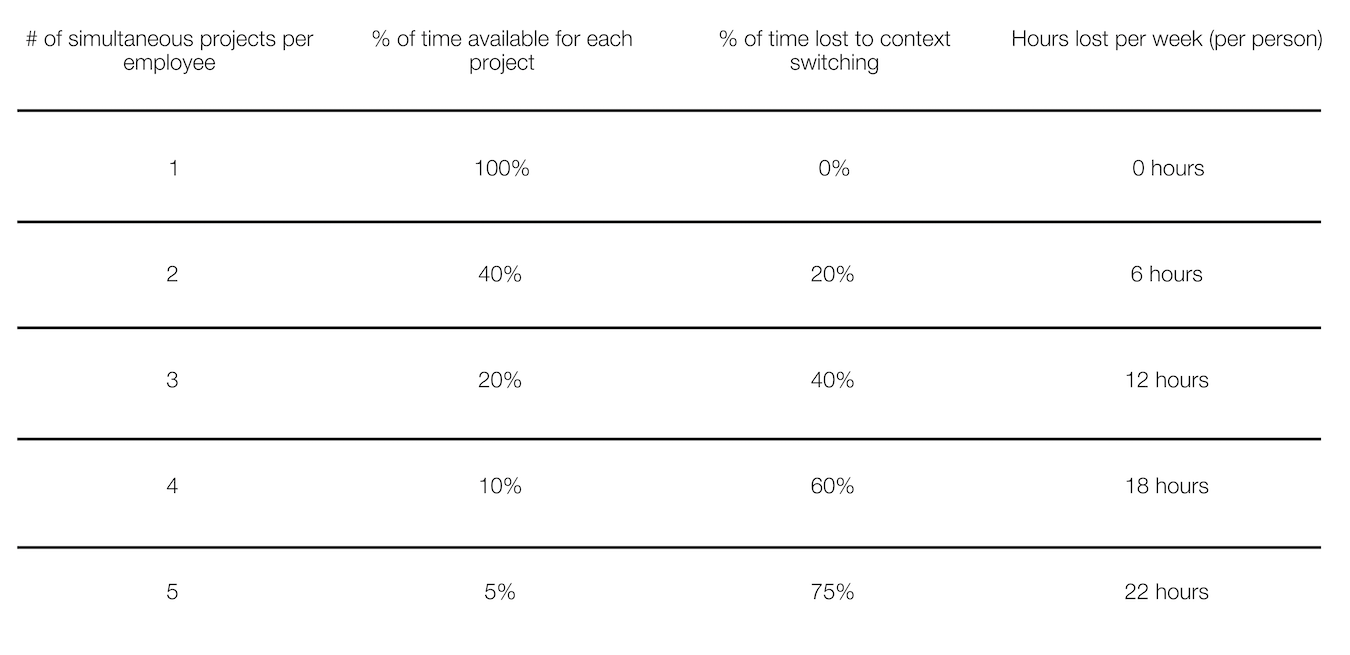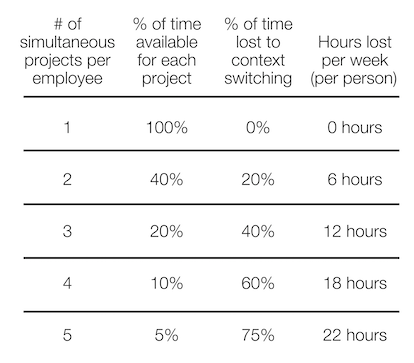Leaders and teams face what feels like unprecedented volumes of work, with catching up seeming like an unattainable dream. Lean Time Management offers some insight into why it's so hard to get ahead.
Keep in mind that there are real, measurable costs of being too busy, not just an inability to get it all done. A study of software coders shows what happens when humans take on too much at once and switch between tasks requiring high-focus (context switching), otherwise known as “multi-tasking". The impact of this is illustrated in the following table.
Keep in mind that there are real, measurable costs of being too busy, not just an inability to get it all done. A study of software coders shows what happens when humans take on too much at once and switch between tasks requiring high-focus (context switching), otherwise known as “multi-tasking". The impact of this is illustrated in the following table.
Using systems and root-cause thinking with an analysis of individual time logs we have worked with teams who have freed-up 12-15 hours per week of their time, and sustained it.
Six themes that prevent you from getting ahead of your work:
- Interruptions, which increase the time it takes to re-start and get back to your previous level of productivity. Some studies suggest that interruptions can cost up to six hours of productivity per day.
- Taking and trying to execute more priorities than they need to – not identifying the “must-do, can’t fail” priorities, putting them ahead of all other work and completing them. The longer it takes to complete a priority, the more time you spend reporting on it, and updating it as the environment around us changes.
- Everyone has a time of day when they are at their peak ability and productivity. Filling those periods of the day with lower-value administrative tasks, instead of completing their most-valuable work, leaves them pushing their value work into low-productivity zones of the day.
- Making unclear requests, so the person doing the work comes back frequently for instructions and clarifications; or accepting assignments without getting more clarity first.
- Meetings that are unfocused, that invite too many people, and whose purpose could have been achieved in a different, lighter, way.
- Providing feedback on proposals, memos, etc. by email instead of face-to-face. This can lead to endless cycles of review instead of a “one-and-done” approach. We have seen review processes reduced by 80-90% by adopting this “one-and-done” approach.
In this content area, we cover:
- How to find and free-up up to 10-12 hours per week so that you can take on more proactive, strategic work and to reduce your involvement in lower-value tasks.
- Realistic work planning so that you deliver on your plans by applying the principles of Lean strategic planning to make plans more accurately reflect available capacity.
- How you as a leader can directly improve flow and reduce waste, particularly the failure demand/preventable work that is currently consuming more of your and your team’s time than you wish.
- How to reduce interruptions and create more focused deep-thinking time to complete more work with less effort.
- How to make better requests and commitments to create less back-and-forth.
- How to optimize the use of my highest-energy time to get more done.
- Create a tangible, specific, and practical plan to get started implementing workshop topics directly into my own work. A copy of their plan is sent back to the participant 60 days after workshop.
- A two-hour follow up session to provide implementation coaching to leaders to help them execute their personal plan.
This content is based on our program offered through the Telfer Centre for Executive Leadership. Many graduates of this program state at the 60-90 day follow up meeting that they have freed up 10-12 hours of their own time per week.
Rybing, T. (2014, October 12). Context Switching – Public Enemy No. 1?. https://theagileist.wordpress.com/2014/10/12/context-switching-public-enemy-no-1/
Weinberg, G.M. Quality Software Management: Vol. 1 System Thinking. New York. Dorset House, 1992. p. 284
Seddon, J. (2019, October 28). Failure Demand: John Seddon Vanguard Consulting. Vanguard. https://vanguard-method.net/failure-demand/



